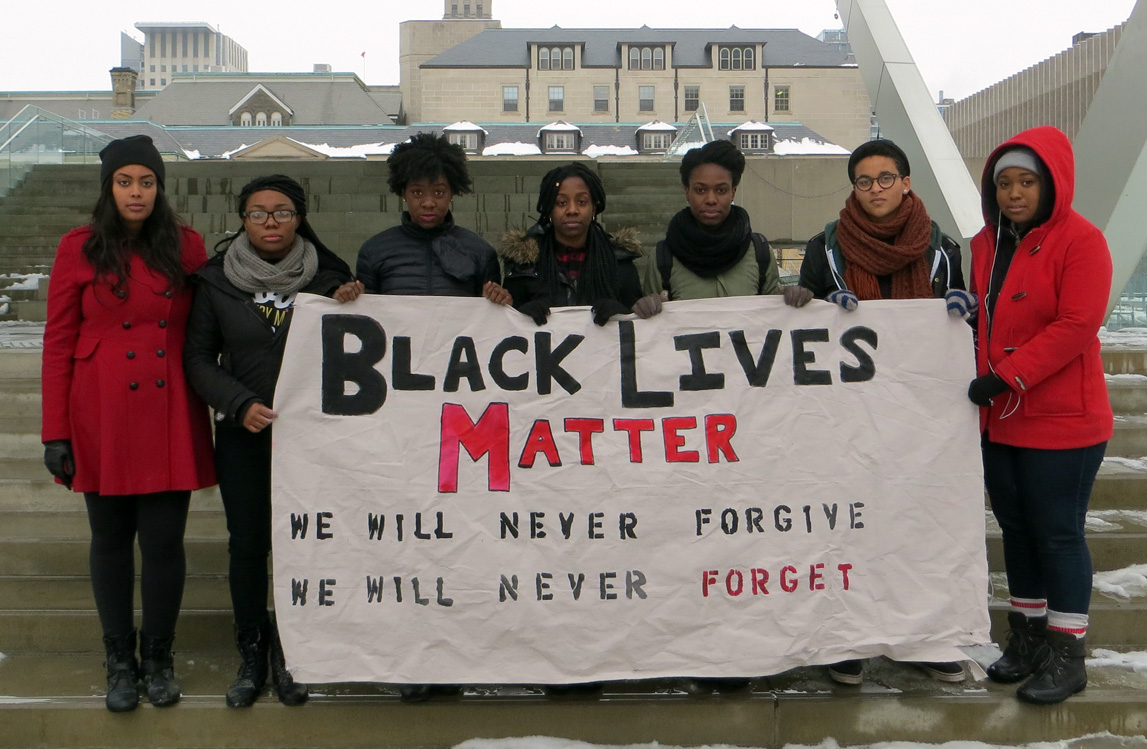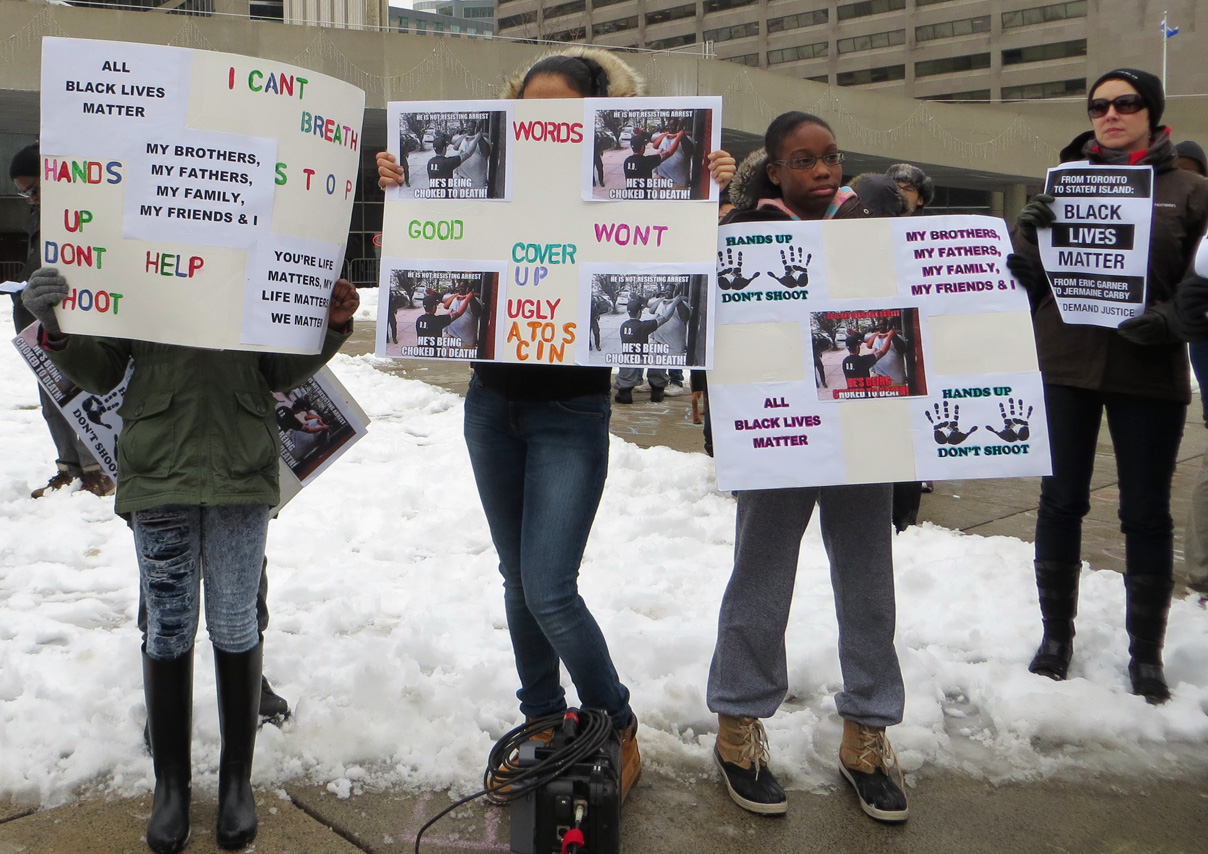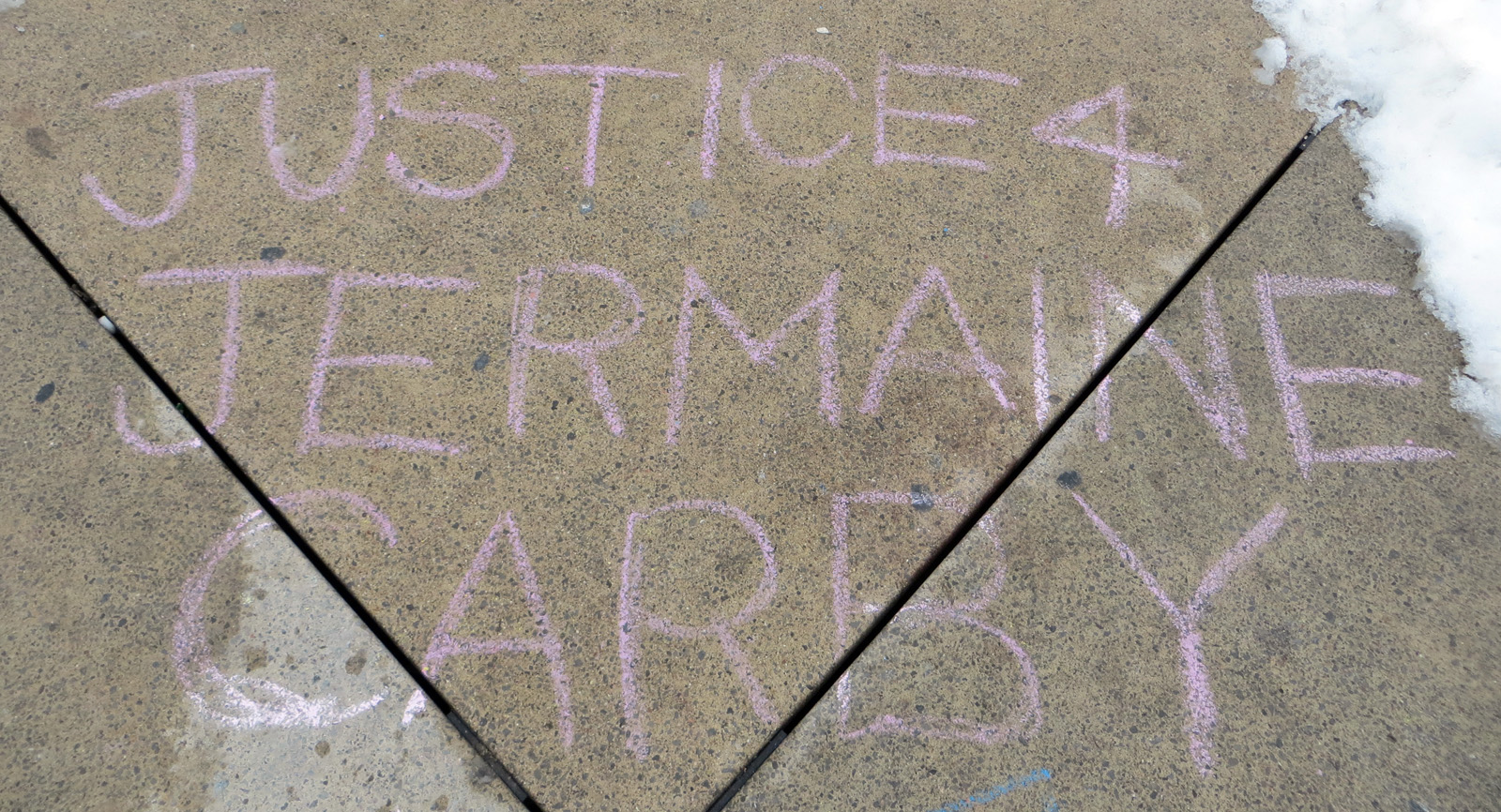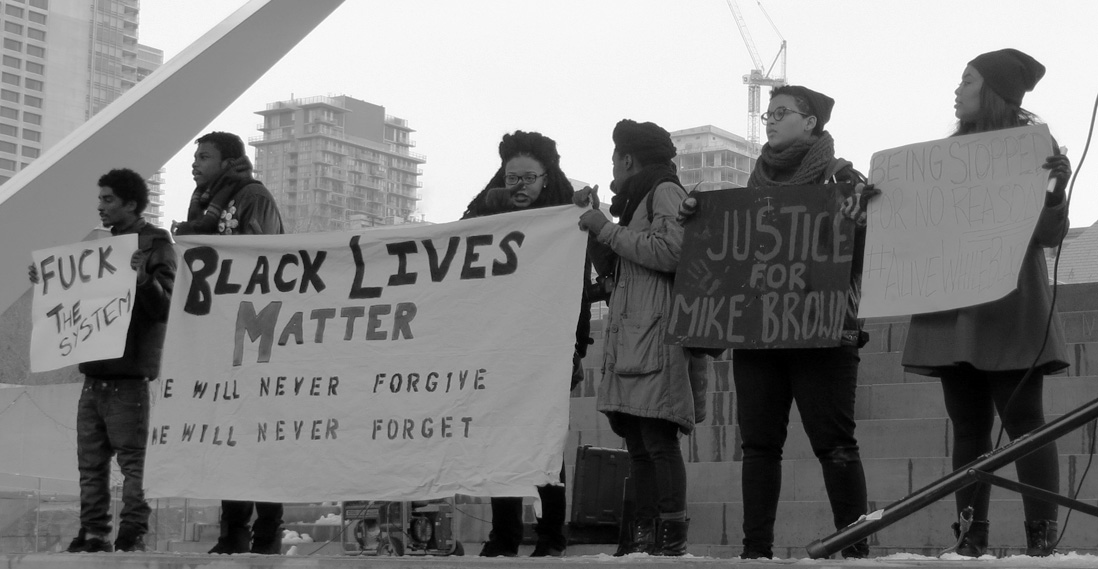For the second time in less than three weeks, hundreds of people marched through downtown Toronto to protest the systemic abuse experienced by Canada’s Black community.
About 300 people gathered at Nathan Phillips Square on Saturday Dec. 13 for the action, which was organized by Black Lives Matter Toronto (BLMTO) in response to state-sanctioned violence and racism, including that of the Toronto Police Service and other local police forces. The group also organized a Nov. 25 protest outside Toronto’s U.S. consulate following the grand jury’s decision not to indict the police officer who killed Michael Brown.

“There are cases of police brutality and Black people dying under suspect circumstances while under police detainment here,” said Sandy Hudson, a member of BLMTO. “We are submitting some requests to city hall to change some of the carding practices, to adopt the recommendations made in the community report and for [Toronto Mayor] John Tory to acknowledge that white privilege exists.”
You can tweet Tory @johntoryTO to ask why he believes white privilege does not exist.
Hudson, who is also the executive director of the University of Toronto Students’ Union, said there is a misconception the Canadian situation is better than other situations abroad, but she insists these issues don’t stop at the border.
“These stories aren’t as publicized in the Canadian media, so part of what we’re trying to do here is make sure the public is aware that, just like in the States, there’s a disproportionate amount of Black people and Indigenous folks filling our prisons. Just like in the states, there’s a disproportionate focus on Black communities when it comes to policing, and all of these things lead to anti-Black racism.”
Saturday’s action began outside city hall, where several people, including Kabir Joshi-Vijayan, a well-known local activist and member of the Justice for Jermaine Carby committee, spoke to the crowd and shared their experiences. The Black community was also encouraged to share their personal stories via social media using the hashtag #AliveWhileBlack.

“As a child white boys told me I was ugly and compared my skin to feces,” read one protester’s sign. Another protester’s sign read “Please don’t let me die” and yet another proclaimed “ALL BLACK LIVES MATTER” in big, colourful letters.
“It was late-July when me and my four cousins walked into a convenience store to buy some refreshments,” said one organizer, speaking to the crowd. “There was already a middle-aged white female at the counter buying an item. We walked by and I heard her say, ‘Watch out for those niggers. They’re bound to steal something.'”
An alarming number of the people on Saturday said they were protesting the same thing their parents were protesting four decades ago: the systemic injustice against the Black community.
While these stories are seldom heard, what is often talked about is the concept of black-on-black crime.
“We’re interested in discussing Blue-on-Black crime,” said Hudson. “The discourse of black-on-black crime is being pushed by right-wing media as a tactic to distract from the real issue at hand: state-sanctioned violence.”
Hudson said the Black Lives Matter movement highlights the realities of the state-sanctioned violence on the Black community, including police brutality, poverty, affordable housing inefficiencies and inaccessible education.
“This is where the real crime lies.”
Hudson called the concept of black-on-black crime a “victim-blaming myth used to deflect blame from the systems that are designed to murder black bodies. What’s more ironic is that it’s used under the moniker of care for the Black community by the same people who deny our real experiences of violence.”
After sharing their stories, the crowd marched to Dundas Square, where the number of protesters grew quickly as people began joining from all directions.

It was here, in the middle of what is arguably Canada’s busiest intersection, where the growing crowd — now nearing 800 people — held a die-in. The crowd lay silent on the pavement for four-and-a-half-minutes, representing the four-and-a-half hours Mike Brown’s lifeless body was left on the road after he was murdered by Ferguson police officer Darren Wilson.
Another non-indictment later — this one complete with video evidence of the murderous cop choking an unarmed Black man named Eric Garner to death — and the song remains the same…
But Black Torontonians don’t necessarily worry about being the next Mike Brown or Eric Garner, for their fear is much closer to home.
Less than three months ago, during a routine traffic stop in Brampton, Ont., 33-year-old Jermaine Carby was shot several times by a Peel Regional Police officer. There is very little else known about the incident, but police are reportedly captured on amateur video saying “drop the knife” — despite no weapon being seen by witnesses or confirmed by police or media.

However, witnesses did report seeing Jermaine with his hands up, and Joshi-Vijayan said Jermaine’s medical report shows one of four bullet wounds in a part of the forearm that would indicate he did have his hands up when he was shot.
While the media continues to flatly question Jermaine’s character and criminal past, the Special Investigations Unit (SIU) has not provided any support or answers to the family, said Joshi-Vijayan.
Jermaine’s mother, Lorna Robinson, also spoke to the crowd about her son’s murder.
“No one knows about it. They just sweep it under the rug like he was nobody. They didn’t even know who he was and what he was about, and I want everyone to know he has been killed in cold-blooded murder.”
Joshi-Vijayan said one doesn’t need to look very far to see that state-sanctioned killing of Black people exists.
“We can look at these terrorists right behind us that call themselves the Toronto Police Service. We can look to the thugs that call themselves the Peel Regional Police. Her son was gunned down with his hands up — not in Ferguson, not in St. Louis, not in New York — in Brampton.”
The Justice for Jermaine Carby committee has placed several demands on SIU Director Tony Loparco, including releasing the name of the officer who shot Jermaine and the name and whereabouts of the driver who was with Jermaine when he was killed. Additionally, the committee is demanding disclosure as to whether a knife was recovered from the scene.
The committee also called on Ontario Attorney General Madeleine Meilleur to disband the SIU as it currently stands.
As was the case with the Nov. 25 protest, organizers asked non-Black allies to maintain a supportive role rather than a central role, allowing the Black community to speak for itself about their experiences. Despite the fact Black protesters and non-Black allies are working together efficiently, various “media outlets” originally seemed upset that white people weren’t able to make their voices the centre of a conversation about Black people’s lives.
However, organizers say BLMTO has been getting “fantastic support” from its non-Black allies.
“One thing we requested right from the beginning was to make sure Black experiences were centred in all of this and Black people were able to speak for themselves,” said Hudson.
“Our allies have been providing us with the necessary materials, supporting us when we need it, writing letters to the media when they try to create a story out of the last action that wasn’t really true to what happened.”

She said BLMTO is working with other racialized communities (no longer considered “visible minorities” because in many cases the non-Caucasian population now accounts for the majority of the total population) as the movement grows internationally.
“Watch out for more actions in the future,” said Hudson. “There is a lot of energy around this.”
Jermaine’s mother said she is grateful for the support her family is receiving and welcomes more people to join the fight because “it could have been your son.”
On Christmas Eve, there will be a candle-light vigil held for Jermaine at the spot near Queen Street and Kennedy Road in Brampton where he was killed by Peel Regional Police.
“We are powerful, and we can do anything that they can do,” said Robinson to loud chants about shame, racist police and systemic abuse. “This is why they try to separate us from each other and try to get us to be against each other: because they know once we are together we are powerful and we can out-do anything!”
Jesse Robitaille is a writer/musician/political junkie who recently graduated with honours from Niagara College’s Journalism program. Previously, Jesse spent two years with the Canadian Forces as an infantry soldier. He’s also in a reggae band from Welland, Ont. called Street Pharmacy. You can visit his personal blog at conchblower.com and follow him on Twitter @robi_wankenobi.



